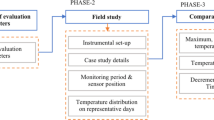Abstract
Evidence is given that the thermal time-constant (ratio of heat stored to heat transmitted) is an effective and simple criterion for the assessment of thermal performance of building fabrics subjected to unsteady heat flow and brings out an optimum value of 20 hr for efficient and economic design. Further, it discusses the mutual interactions between the internal surface temperatures of an enclosure suggesting the inadequacy of the time-lag property concept of any building element taken individually.
Zusammenfassung
Es wird nachgewiesen, dass die thermische Zeitkonstante (d.i. das VerhÄltnis von WÄrmespeicherung zu WÄrmedurchfluss) ein ausreichendes und einfaches Kriterium für die AbschÄtzung der thermischen Vollkommenheit von GebÄuden ist, die einem unstetigen WÄrmeeinfluss ausgesetzt sind und einen optimalen Wert von 20 Stunden als ausreichend und ökonomisch aufweisen. Ferner interpretiert diese Grösse die wechselseitige Beziehung zwischen den OberflÄchentemperaturen im geschlossenen Raum und weist darauf hin, dass die Summe der Zeitkonstanten eines jeden einzelnen Bauelementes für sich nicht als Gesamtmass brauchbar ist.
Resume
I1 est prouvé ici que la constante thermique de temps (rapport entre la chaleur emmagasinée et la chaleur transmise) est un critère simple et suffisant pour définir les propriétés thermiques des éléments constitutifs d'immeubles. Ce rapport correspond à un flux de chaleur non-uniforme et atteint son optimum au voisinage de 20 heures comme valeur d'efficacité en tenant compte de facteurs économiques. On discute en outre l'action réciproque de la température des surfaces intérieures d'une pièce. On démontre enfin que la somme des constantes de temps de chaque élément de l'immeuble pris individuellement n'est pas propre à définir l'ensemble.
Similar content being viewed by others
References
GUPTA, C.L. and RAYCHAUDHURI, B.C. (1963): Thermal circuit analysis of unconditioned buildings. J. Inst. Engrs. (India), 44: 29–46.
FUJII, S. (1962): Analysis of room temperature by means of weighting function. B.R.I. Occasional Report No. 8, Ministry of Construction, Japanese Government.
MIN, T.C., SCHUTRUM, L. F., PARMELEE, G. V. and VOURIS, J. D. (1956):Natural convection and radiation in a panel heated room. Trans. Am. Soc. Heat Air Cond. Engrs., 62: 337–358.
MUNCEY, R.W. (1953)5: The calculation of temperatures inside buildings having variable external condition. Aust. J. appl. Science, 4:189–196.
PRATT, A.W. and BALL, E.F. (1962): Transient cooling of a heated enclosure. Dept. Sci. Industr. Res., Building Research Station, U.K. Note No.E 1243.
RAYCHAUDHURI, B.C. (1961): Thermal performance of light weight structures in tropics. J. Nat. Buil. Org. India, 6: 3–14.
RAYCHAUDHURI, B.C. and CHAUDHURY, N.K.D. (1961/62): Thermal performance of dwellings. Ind. Const. News., 38–42.
STEPHENSON, D.G. (1962): Methods of determining non-steady state heat flow through walls and roofs of buildings. J. Inst. Heat. Vent. Engrs., 30: 64–73.
Author information
Authors and Affiliations
Rights and permissions
About this article
Cite this article
Raychaudhuri, B.C., Jain, S.P. & Yadva, K.G. Thermal characteristics of unconditioned insulated masonry buildings in hot arid regions. Int J Biometeorol 8, 137–145 (1964). https://doi.org/10.1007/BF02187578
Issue Date:
DOI: https://doi.org/10.1007/BF02187578




